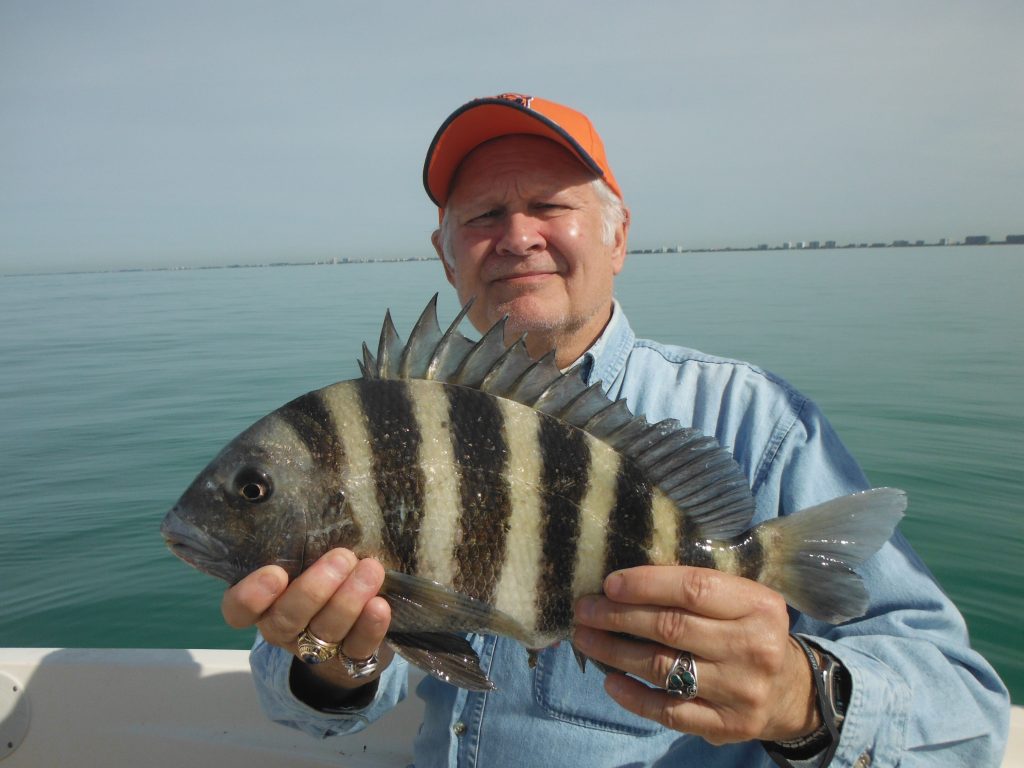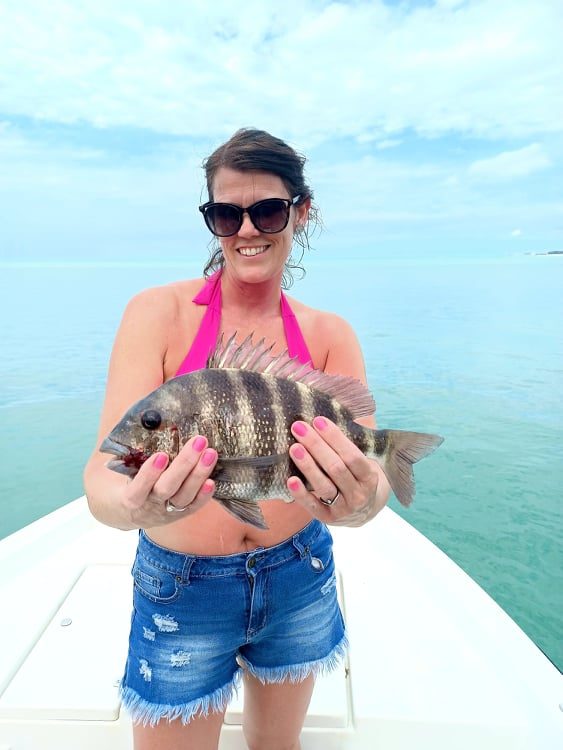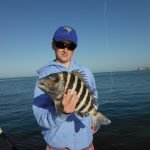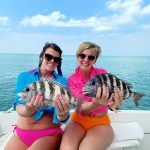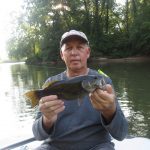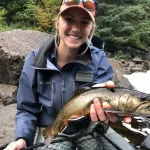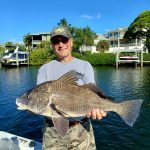Best Sheepshead Fishing Tackle and Baits
This post is all about the best sheepshead fishing tackle and baits. Sheepshead are a hard fighting and great tasting member of the porgy family. They are found near structure in inshore saltwater bays, inlets, and near shore waters of the Atlantic Ocean and Gulf of Mexico. They feed primarily on crustaceans such as shrimp and crabs. Sheepshead range from Texas all along the coast up to new England.
One of the great things about fishing for sheepshead is that they are one of the less finicky fish species. They have saved the day for many an angler when the water was cool and dirty. Another great attribute of sheepshead is that anglers do not need a ton of skill to have a successful day. Once again, this is very basic bottom fishing with a few nuances. However, anglers will need the proper tackle, rigs, and bait in order to be successful.
The best sheepshead fishing tackle is a 7 foot medium or medium light action rod with a fairly limber tip. The best baits for sheepshead are live shrimp, fiddler crabs, sand fleas, oyster crabs, and clams. While sheepshead pull hard, they bite very lightly. A soft tip will allow anglers to feel the bite while a stout butt section enables the angler to horse the fish away from structure. The rod should be matched with a 2500-3000 series reel spooled up with 12 pound monofilament or 20 pound braided line.
Anglers fishing for sheepshead will do well using standard bottom fishing techniques. Sheepshead are almost always found either on bottom structure or close to vertical structure such as bridge pilings and piers. Sheepshead have an unusual set of teeth that they use to cross shells of mollusks and barnacles. They then devour the animal living inside the shell. Sheepshead are very seldom caught by anglers using artificial lures.
Capt. Jim Klopfer has been running fishing charters in Sarasota Florida since 1991. He targets a wide variety of species throughout the year. Many of his clients include children and novice anglers. Also, conditions are often less than ideal in the winter. Add to these factors the excellent eating quality, and you have several reasons why he targets sheepshead throughout the winter and early spring.
Best sheepshead fishing tackle
Fortunately, anglers seeking the best sheepshead fishing tackle can keep it quite simple. In fact, most anglers who do any inshore saltwater fishing most likely already own a suitable rod and reel combination. Sheepshead average from 2 pounds to 5 pounds and are normally found around structure. For this application, a medium spinning outfit works best. It allows anglers to enjoy the fight of the fish while still being able to handle it around structure.
The best all round spinning outfit is a 7 foot medium or medium light action rod with a fairly limber tip. While sheepshead pull hard, they bite very lightly. A soft tip will allow anglers to feel the bite while a stout butt section enables the angler to horse the fish away from structure. The rod should be matched with a 2500-3000 series real spooled up with 12 pound monofilament or 20 pound braided line.
Anglers can shop at Amazon for a Daiwa Black Gold reel and St Croix Triumph 7′ MF rod spinning combo in this link.
“Fishing Lido Key is a participant in the Amazon Associates Program, an affiliate advertising program designed to provide a means for sites to earn advertising fees by advertising and linking to Amazon. As an Amazon Associate I earn from qualifying purchases.”
Anglers can use a light conventional outfit as well. These are known to some as bait casting rigs. These are more appropriate for anglers vertically fishing over racks and other submerged structure. They are a bit more difficult to cast. However, they work very well when pursuing larger fish.
Sheepshead fishing rigs
There are several standard bottom rigs that work well for anglers sheepshead fishing. These include a dropper, or chicken rig, sliding sinker or Carolina rig, knocker rig, or a simple free line rig. Each has advantages and situations where they work best.
Freeline rig
The easiest and simplest fishing rig for sheepshead is to free line a live bait back to the fish. This rig simply consist of a leader, a hook, and a split shot or two if required. The advantages of this rig are that the bait land softly, resulting in a more delicate presentation. Also, with no weight, the fish can pick up the bait and move off without any resistance.
This rig is used primarily around structure such as docks and oyster bars in fairly shallow water. In deeper water, especially with any current present, the bait will not usually get down deep enough. It is extremely effective around oyster bars in the mouths of feeder creeks.
Carolina rig
The sliding sinker rig, known to many as a Carolina rig, is perhaps the most commonly used in versatile rig for sheepshead fishing. It consists of an egg sinker, which has a hole through the center. The running line goes through this whole and then a swivel is attached. The swivel both stops the sinker from moving any further as well as giving a place to attach a leader. A 2 foot to 3 foot leader followed by a hook completes the rig.
The beauty of the Carolina rig is that the sliding sinker allows a sheepshead to pick up the bait and move off with it without feeling any resistance. This can be crucial on days when the bite is very light and delicate. The sinker weight can be changed and adjusted to match the current fishing situation. Water depth and current speed are the most important factors. Anglers should use the lightest weight possible to reach and hold the bottom.
Knocker rig
The knocker rig is similar to a Carolina rig with one big exception. The sinker slides onto the leader just above the hook. When lower down to the bottom, the sinker actually sits right on top of the eye of the hook. The main advantage to this rig is that anglers will know exactly where the bait is; when the sinker is on the bottom, the bait is on the bottom.
The knocker rig is most often used around fairly heavy structure where other rigs will snag the bottom. By keeping the hook in sinker and one location, hangups are limited. When the hook does snag, a sharp jerk of the rod tip will send the sinker up the leader and and sliding back down to the eye of the hook, knocking it free. This is how it got the name.
Dropper rig
Dropper rigs, also known as chicken rakes, are very effective for sheepshead as well. They consist of a sinker at the bottom, with hooks tied off on short droppers at different intervals. This allows anglers to present multiple baits at multiple levels at the same time. This is a standard bottom fishing rig which has been producing for many, many years.
This is the rig to choose for anglers vertically fishing and drifting. Normally, a bank sinker is used. The sinker tends to bounce off of and rollover rocks and other obstructions. This does not work well on reefs and wrecks where snags are really bad. At some point, the rig will hang up on the bottom. This rig will catch a variety of other species for anglers bottom fishing off of structure.
Best hooks for sheepshead fishing
Obviously, what piece of sheepshead fishing tackle that anglers will need is a hook. Hooks come in a wide variety of sizes, styles, and strengths. For most sheepshead fishing situations, a #1 or #1/0 short shank live bait hook works well. Sheepshead have a very strong by and a stout hook is required. Many anglers have gone to circle hooks as well. When used properly, the hookup ratio is high in the fish are almost always hooked in the corner of the mouth. They are required in many parts of the Gulf of Mexico. #4/0 is a good all-around hook size.
Sinkers
Sinkers are another item that sheepshead anglers will need in their tackle boxes. However, only a few sizes and styles are really needed. A selection of egg sinkers from 1/2 ounce to 2 ounce, bank sinkers from 1 ounce to 4 ounce, and a couple bags of split shot will get the job done.
Leaders and swivels
Most sheepshead anglers tie their own rigs. Those do will need leader material and swivels. The leader strength is determined by the clarity of the water, the size of the fish being pursued, and the structure being fished. In most cases, 30 pound fluorocarbon leader is all that an angler needs. #10 black swivels are a good all-around choice. Most local bait shops to sell pre-made rigs for anglers who do not want to tie their own.
Best sheepshead fishing baits
As mentioned above, the vast majority of sheepshead are landed by anglers using natural bait. Occasionally, sheepshead will take it artificial lure, but this is the exception and not the role. Top sheepshead baits, either live or frozen, include shrimp, fiddler crabs, sand fleas, oyster crabs, oysters, and clams.
- Shrimp
- Fiddler crabs
- Sand fleas
- Oyster crabs
- Oysters and Clams
Shrimp
The number one bait for anglers fishing inshore salt waters from the Carolinas south and around the Gulf Coast is shrimp. They are available at every bait store in that area. Live shrimp are very effective sheepshead baits. While some anglers consider some other baits more productive, it is hard to beat the convenience with which fresh or frozen shrimp can be obtained. Fresh dead shrimp works well, as does frozen shrimp.

Fiddler crabs
Fiddler crabs are available at some coastal bait shops. However, they are much less prevalent than are shrimp and other baits. Serious sheepshead anglers catch them on the title flats at low tide. There are easy to see as a mass of them scurries about with their one claw shaking angrily up in the air. These are fantastic sheepshead fishing baits, perhaps the best of them all.
Sand fleas
Sand fleas, whose proper name is more crab, are a popular bait for anglers surf fishing for a variety of species. Live sand fleas are hardly ever sold at bait shops, though some do carry frozen ones. Most anglers catch them in the surf is a fish using special sand flea rakes. As the surf comes in, angler scoop out a bunch of sand and shell, sifting out the sand and hoping there’s a few sand fleas left.
Oyster crabs
Oyster crabs and other small crabs are also very good sheepshead fishing baits. However, anglers using these almost always have to catch them themselves. They are mostly found around rocks and oysters that are submerged at high tide but exposed at low tide. While quite a bit of effort to procure them, many sheepshead anglers consider it worth the trouble.
Oysters and clams
Oysters and clams are a very good an underutilized sheepshead fishing bait. They are easy to obtain and use. They can be purchased at grocery stores, fish markets and bait shops. Razor clams are favored in some areas. Clams are tough baits would stay on the hook well. Most anglers cut them into bite-sized pieces for the sheepshead.
Hooking sheepshead
Many anglers new to the sport of sheepshead fishing have a lot of difficulty hooking them. There are a couple mistakes that many novice anglers make. Capt. Jim will share a few tips and techniques which will help these anglers hook more of these feisty saltwater panfish.
What mistake many anglers make when sheepshead fishing is moving the bait too much. Capt. Jim likes to cast the lure out towards likely structure, or drop it to the bottom when fishing vertically in deeper water. Once the bait comes to rest on the bottom, the slack is reeled out of the line. The angler then holds the rod tip low and keeps the bait motionless while waiting for a bite.
The bite usually begins with a fairly distinct “tap”. This is where many anglers make their first mistake, they want to move or gently lift the bait. That is a mistake! The best approach is to keep the bait motionless. Many times there will be a series of taps. However, at some point the sheepshead will either get the bait or picking up and move off with it.
This is where the other mistake comes into play. Once that slow steady pull is felt, many anglers want to set the hook. Again, this is a mistake and is especially true with anglers using circle hooks. Instead, the technique that works best for Capt. Jim is to real fast and hard while slowly lifting the rod tip up high. This will remove all the slack from the line and start the hook in the sheepshead’s mouth.
Sheepshead fishing spots
Just about any structure can hold sheepshead when they are in the area. Oyster bars are extremely productive and backwater areas were title creeks and rivers are prevalent. The same holds true for shallow water bays between the mainland and the barrier islands. The best approach when fishing oyster bars for sheepshead is to free line a bait out where the oyster bar drops off into slightly deeper water.
Docks and bridges are prime spots for sheepshead as well. These provide both overhead cover and shade as well as vertical cover in the form of pilings. Bridges and docks and water 10 feet or shallower should be fished a distance away and cast towards. Anglers fishing deeper bridges and docks can do so with a vertical presentation both knocker rigs and sliding sinker rigs work well.
Inlets and passes are prime spots to target sheepshead as well. Most have abundant structure in the form of docks, seawalls, bridges, and submerged rock piles. In many areas, these are the spots that sheepshead school up in big numbers to spawn. The best time to fish these areas is usually on the turn of the tide when the water slacks up. It is just too difficult, and sometimes dangerous, to anchor in the swift current. Knocker rigs and spreader rigs work well.
Reefs and wrecks in the inshore waters of the Atlantic Ocean and Gulf of Mexico will also hold plenty of sheepshead as well. Also, in some areas these tend to be the largest fish. Anglers can anchor or drift in most cases a vertical presentation with a spreader rig is the best choice.
In conclusion, this article on the best sheepshead fishing tackle and baits should help anglers catch more of these hard fighting and great tasting saltwater panfish!
